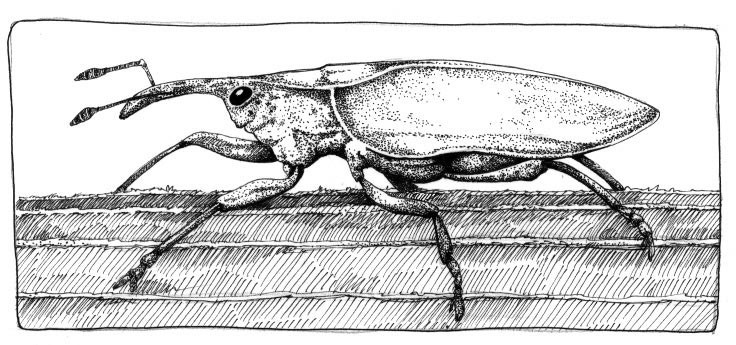
A white pine weevil close up or, even better, seen through a hand lens, is so silly looking it will make you laugh. This plump, quarter-inch-long beetle (Pissodes strobi) has a tapering head that narrows to a long snout with chewing mouthparts at the end. Two antennae sprout from the snout, and first aim backwards, in the wrong direction, then take a sharp bend and head forward. Overall, the beetle looks like a harmless Dr. Seuss character.
But, far from harmless, it is the most economically damaging pest of eastern white pine. The feeding of its larvae kills the terminal shoot and bud cluster, destroying at least two years’ growth and leaving several side branches to compete for dominance. This competition at best leaves a bent tree trunk, but just as often the tree forks, which drastically reduces the likelihood that it will ever produce a halfway decent sawlog.
Some trees get nailed again and again by weevils, leaving a disordered mess of stems. These pines often appear as round as cabbages, and I call them cabbage pines – though I don’t think I invented the name.
On warm days in April, adult beetles begin emerging from their winter quarters in the leaf litter just as white pine buds begin to swell. Both males and females crawl or fly to the treetops where they feed and mate – for good measure, perhaps, for most of them have mated the autumn before and the females retain viable sperm.
Preferring sunlit, vigorous, fat, terminal shoots, the females chew holes just below the bud cluster and lay a couple of eggs in each hole, covering the opening with a protective wad of excrement. Usually two or three females will lay eggs in the same shoot. If only a few eggs are laid in a shoot, the tree may produce enough pitch to drown the larvae when they hatch. If, on the other hand, too many larvae hatch, some will starve. Each female lays a total of about 100 eggs.
Heads down, tails up, the larvae descend as they feed in the cambium and inner bark. As they grow, their feeding tunnels coalesce, girdling and killing the stem. After five or six weeks of feeding and molting, they make protective cocoons of wood chips and metamorphose into adults.
At first the damage caused by the feeding larvae is not visible, but by June the wilted terminal shoots of the pine tree have turned from yellow to brown. Left alone, the dead leader persists for many years and may be an entrance point for Phellinus pini, the major heart rot disease of older white pines. Before mid-July, when adult weevils begin to emerge, is the best time to prune and burn the infested part, if it is within reach. And while you are there, removing all but the best lateral shoot will make it easier for the tree to get itself straightened out.
From late July to early September, adult weevils emerge through BB-shot-sized holes and begin to feed on buds and bark tissue. By late October almost all have dug themselves into the litter, most of them within eight inches of a white pine.
Though a native pest, its natural enemies – including a fly, a couple of wasps, many birds, and small mammals (during the winter) – do not provide control. The heavily sodded fields, which dense even-aged stands of pine have taken over following the abandonment of agriculture, are a weevil’s delight. Heavy clay soils seem also to be preferred by the insect.
Tree resistance does seem to vary, and planting white pine at close spacing – preferably with a mix of other species – reduces the damage somewhat. The weevils like full sun, so partial shade can be helpful, though the trade-off is that more than 40 to 50 percent shade will slow a pine’s growth significantly.
People who don’t know the natural elegance of a straight white pine sometimes prefer the shape of a cabbage pine. Once the weevils have killed a tree’s central leader, the tree seems to grow more vigorously than a straight one, pouring forth hundreds of would-be terminal branches where there otherwise would be but one. It will be twice as big next year as this year, so the best time to get rid of a badly weeviled pine is right now. Unless you are trying to grow a hedge.

